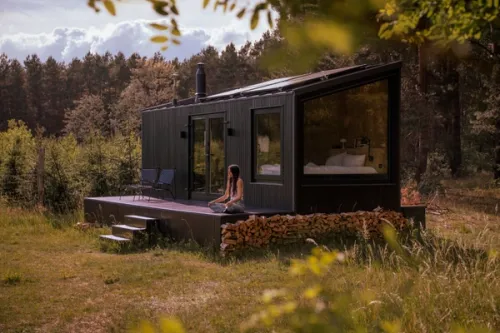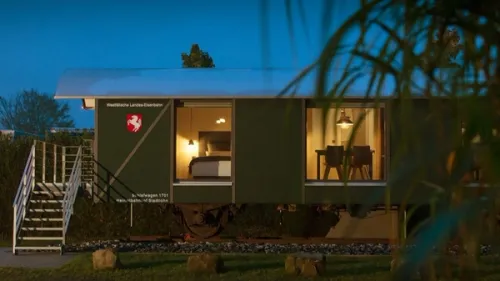Size
110 square kilometers
Bundesland
North Rhine-Westphalia
Known for
Diverse landscapes
Best time to visit
All year
By Emily, Founder of Staycation Collection
Six can't miss outdoor activities in the Eifel National Park

It’s bizarre to me that Germany is still a hugely underrated tourist destination; equally, I find it bizarre that of all Germany’s exceptional landscapes and national parks - from the Baltic Coast and Black Forest to Saxony-Switzerland and mountain lakes of Bavaria - the Eifel National Park in North Rhine-Westphalia is very, very rarely mentioned by German friends or travel experts as someone you just have to visit, especially as it’s so close to Bonn, Cologne and Düsseldorf.
On the flip side, it means the park is quiet, and I can brag about spotting meteors, tracking wild cats and hiking on volcanoes, knowing that not many others will have the same stories to share.
I love the Eifel National Park, and often feel overwhelmed by the beauty of the natural world (in a good way), from its unspoilt night’s sky to reintroduced wildlife and ancient forests. With this in mind, these are the six outdoor activities you simply cannot miss, and once you’ve experienced them for yourself, I challenge you to not fall in love with the Eifel.
It’s worth noting that there are two protected parks in the Eifel region: the Eifel National Park in NRW and the Vulkaneifel in Rhineland-Palatinate. This post is about the former.
(The Eifel National Park is considered a National Park in Development, and its focus is on biodiversity and natural landscapes, and aims to protect ecosystems and promote wilderness within North Rhine-Westphalia. The Vulkaneifel Geopark, a UNESCO Global Geopark, focuses on the region's volcanic geological heritage within Rhineland-Palatinate.)
Don't Get Fomo
Fernweh Newsletter
Discover Germany, beyond its tourist spots: get adventure tips and day trip inspiration straight to your inbox. Every month, for free. Sign up so you don’t miss out.



1. Go hiking through ancient beech forests
Eifel National Park is home to some of Europe's most pristine and ancient beech forests. It’s hard to imagine what Europe would have looked like completely covered in forests, but walking amongst these impressive trees gives an atmospheric insight. Hiking through these dense, leafy canopies, you are enveloped in a world that has remained largely unchanged for thousands of years, and luckily for us, the park has made a significant effort to preserve the impressive biodiversity, such as nurturing rare species like European orchids (yes, apparently these are a thing…!) and various species of sundew (a type of carnivorous plant, say what?!).
I love the Wilderness Trail, which is an 85 km walk broken into four stages, that winds through varying altitudes and landscapes (and claims to be a walk shaped by wildcats).
2. Head into the wilderness to watch wildlife
The Eifel National Park has been working hard to reestablish a diversity of native animals in the region, and heading out with a pair of binoculars or a camera is a lot of fun.
I was amazed to discover European Bison, Europe’s largest land mammal, and I was sad that I didn’t spot any nocturnal European Wildcat. There are numerous birds, too, such as the Black Stork and Eurasian Eagle-Owl. Oh, and there are venomous snakes (the European Adder) here too, so watch out…
Dedicated wildlife-watching tours and hides are set up, offering a chance to observe these animals in their natural environment.


3. Cycling routes you can’t miss
Of course, exploring by bike is also big here, and the RurUfer-Radweg is a fun stretch of cycling paths that allow you to take in nature and some dark history.
The route passes Ordensburg Vogelsang, the National Socialists’ former educational centre. Rather than destroying it, there was a movement to take back the area and transform the energy into a positive one. The complex, now proudly called Vogelsang IP has been redeveloped as an international place for tolerance, diversity and peaceful co-existence. It might sound heavy for a mini-break, but it’s well worth it.
4. Stargazing in one of Germany’s International Dark Sky Park
Stargazing is one of my all-time favourite things to do. There’s something so humbling about watching the Milky Way appear overhead. The dark skies of Eifel National Park have been designated as an official International Dark Sky Park, meaning there is very little light pollution, making it much easier to see stars, planets, and meteor showers.
Night sky events are seasonal, so be sure to check an astrological calendar to see what events are upcoming. There are designated stargazing spots within the park, which offer unobstructed views of the sky, but for beginners, I recommend heading to the Vogelsang Observatory where the group “Stars without Borders” organise regular workshops (book ahead, they fill up fast; DE only, EN on request).

5. Kayaking and paddleboarding on Rur Lake
Rur Lake (Rursee) has spectacularly clear waters and is surrounded by dense forest, making it a really restorative place to head out on the water. You can rent kayaks and paddleboards, or simply dive in and go for a swim.
If you’re feeling a little less active, head to the beaches of Rurberg and Eschauel to chill out and kick back.
6. Visit the picture-perfect Monschau Castle
Ok, visiting this Medieval Castle might night technically fall into the category of outdoor activity, but it’s one of the top things to do in the Eifel National Park.
Sat above the charming town of Monschau (also well worth a visit thanks to its gorgeous half-timbered houses), Burg Monschau (Monschau Castle) dates back to the 13th century. A climb to the top of the hill gives a breathtaking view of the rolling hills of the surrounding Eifel region. Throughout the year, Monschau Castle has a calendar of cultural events, including classical concerts and historical reenactments.

Plus… Some bonus seasonal activities
Of course, nature is nature, meaning there are numerous season-specific activities, but two worth keeping in mind are:
- Winter: the park tends to get good snow coverage, making it perfect for snowshoeing or cross-country skiing
- Autumn: the ancient forests are stunning as their leaves turn yellow, red and brown


